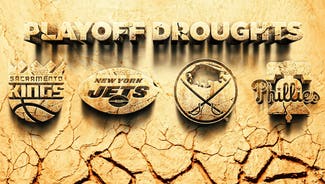
Hockey is cleaner when gloves come off
As a 5-foot-9, 185-pound producer of 264 goals and just two fights in 14 seasons, Danny Briere might be expected to be the prototype of a player who wants the ice free of goons. Instead, he believes he is typical of skilled players who have a greater fear of an NHL without fighting.
"For people who haven't played, sometimes it's tough to understand," said the Philadelphia center. "But most players feel fighting leaves the game cleaner.
"Guys like (the Rangers') Sean Avery, (Buffalo's) Patrick Kaleta, (Vancouver's) Max Lapierre who run around and do dirty plays have to answer for their acts. You take fighting out, every team would have four or five of them.
"Fighting makes those guys pick their spots. And when they cross that line they have to answer the bell."
Bells seem to be ringing incessantly in NHL players' heads during an epidemic of concussions to high profile players such as Pittsburgh's Sidney Crosby, Boston's Marc Savard and Philadelphia's Chris Pronger.
Evidence of Chronic Traumatic Encephalopathy, a ticket to dementia found in the donated brains of deceased enforcers Bob Probert and Derek Boogaard suggests an increasingly indefensible position being taken by the only professional league that allows fighters to return to action in the same game.
But only 6 percent of the 260 concussions recorded between October 2006 and January 2010 resulted from fights, which have occurred in only 34 percent of the first 524 league games this season, down from a 37 percent average over the previous 10 years.
"Unlike in my day, you can turn down a fight," said Edmonton GM Kevin Lowe.
The larger safety concerns stem from body collisions by players two inches taller and 30 pounds heavier than they were in 1955 and skating at higher speeds. Still, the issue cannot be separated completely from fighting because more players are hitting without fear of consequence.
"The game was safest when players were allowed to defend one another," said Bob Clarke, Flyers' Hall of Fame center and their senior vice president after 23 years as an NHL GM. "The league has taken all that out.
"Two referees were put in not to make the game better but to make sure players couldn't get even with each other. Players who never threw a check now hit because there are no repercussions. The league has been suspending players forever and it never has stopped the goofiness."
Therefore players see as much value as ever in the occasional fight. So the league skates away from do-gooders assaulting the hockey culture with misguided pacifism.
"There are a handful of (hockey) people opposed to fighting but no real debate inside the game," said Toronto GM Brian Burke. "It comes from outside and therefore merits little attention."
The delighted faces on the other side of the glass during a fight tell you they sell tickets, even ones for which the only provocation is two guys trying to keep themselves in the league.
"First of all, somebody could be settling a score from the last game or a year ago so what's staged?" said Burke. "But the battleships have been phased back significantly, the burden shifted to middleweights and when some of them are rats they have to be made to pay up.
"Fighting as a tactic is down. But like hunting, if you don't think fighting is a good activity, I probably can't convince you."
Likewise, Burke remains unconvinced that what was found in Probert's and Boogaard's brains is a manifestation of merely bare knuckles.
"They had (documented drug) addiction issues," said Burke. "How much of the (CTE) was attributable to that, I don't know and I don't think anybody does either."
Dave Schultz, the baddest of Philadelphia's Broad Street Bullies, whose tactics in winning Stanley Cups in 1974 and 1975 inspired crackdowns against instigators and mass brawling, today has his full faculties. He believes that wouldn't be the case had he played in this era.
"I was 200 pounds, I really couldn't hurt anybody like these 240-250 pounders today," he said. "I told (former Montreal enforcer) George Laraque one time 'you're going to kill somebody.' "
Notorious as he was, Schultz scored 20 goals in 1974-75.
The concentric circles of a 94-year-old debate — when founded in 1917, the NHL considered a fighting ban — always lead back to the ethics or functionality of deploying missiles for punitive purposes only.
"With the speed today you need four lines, meaning your guy there for protection also has to play a defensive role," said John Davidson, St. Louis Blues President of Hockey Operations.
"Our game will sell well if fighting disappeared, I don't worry about that," he said. "But you need some level of policeman.
"In a union of 700 persons, I assume fighting would be gone if 600 wanted it out. But they don't."

